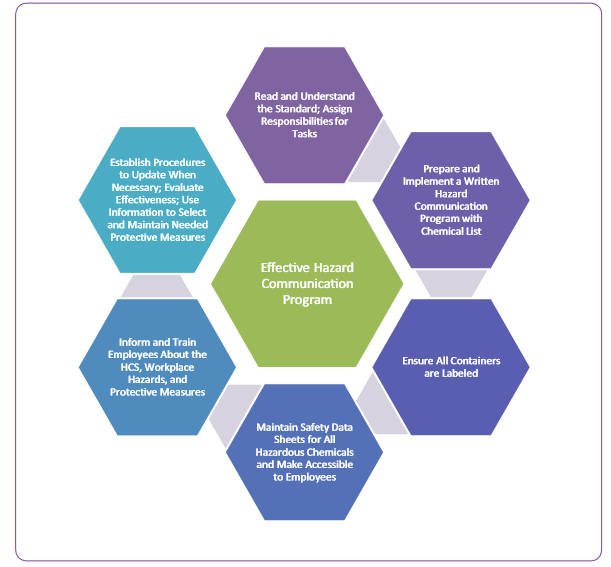
Last week we discussed Hazard Communication, Part I.
This week we are going to discuss Step 3 for creating a Hazard Communication program.
Step 3) Ensure containers are labeled
The Haz Com standard for labels conforms to the United Nations’ Globally Harmonized System of Classification and Labeling of Chemicals. This standard requires labels to have the following elements: product identifier, signal words, hazard statements, pictograms, precautionary statements and name, address & phone number of the manufacturer or responsible party.
The product identifier is any chemical name, common name or trade name the manufacturer chooses to use on the label and it must also appear on the safety data sheet.
A signal word is used to indicate the relative level of severity of hazard and alert the reader. The signal words used in the standard are “danger” and “warning”. Danger is used for the more severe hazards, while warning is used for less severe hazards.
A hazard statement is assigned to a hazard class and category that describes the nature of the hazards and, where appropriate, the degree of the hazard. Examples include:
- Harmful if inhaled.
- May cause respiratory irritation.
- And may cause allergy or asthma symptoms.
A pictogram is a symbol plus other graphic elements, such as a border, background pattern, or color that is intended to convey specific information about the hazards of a chemical. Each pictogram consists of a different symbol on a white background with a red diamond border. On an A-side, iso label, you see pictograms for health hazard because iso is a respiratory sensitizer, the exclamation mark identifies iso is an irritant and the yellow caution sign warns do not mix with water.
A precautionary statement is a phrase that describes recommended measures to be taken to minimize or prevent adverse effects resulting from exposure to a hazardous chemical or improper storage or handling of a hazardous chemical. Examples include:
- Avoid breathing dust, mist, vapors or spray.
- Do not eat, drink or smoke when using this product.
- And, wash skin and face thoroughly after handling.
And finally, the name, address and phone number of the manufacturer or other responsible party.
Generally it is recommended to maintain the original manufacturer’s label. And when chemical is transferred to unmarked containers, OSHA requires these containers be labeled with the identity and hazard information, except when transferred for immediate use by the employee who performed the transfer.
Some employers use third-party workplace label systems, such as the Hazardous Material Information System (HMIS) and the National Fire Protection Association (NFPA). However, the information supplied on these labels must be consistent with OSHA’s Hazard Classification Standard. The HMIS refers to hazards during anticipated use while the NFPA system describes hazards under fire conditions; therefore, the two systems may have slightly different hazard categories for the same material. A typical HMIS hazard-warning label ranks the hazard the material poses from 0 to 4 in three categories: Health, Flammability, and Physical Hazard. A rank of 0 indicates that the material presents a minimal hazard for that category. A rank of 4 indicates a severe hazard for that category. The HMIS label also may depict the type of PPE required, but the narrative descriptions on the drum label and in the SDS should be reviewed.
A typical NFPA hazard-warning label uses four small diamonds to make up a larger diamond.
Each small diamond contains a numerical ranking, again on a 0 to 4 scale, for the severity of the hazard in four categories: health in blue, fire or flammability in red, instability in yellow and other significant hazards, such as reactivity with water, in the white.
Stay tuned next week as we discuss Step 4 of creating a hazard communication program.
Subscribe here to keep in touch with Spray Foam Advisor and get your FREE copy of 25 SPF Frequently Asked Questions and a PRIVATE link to Robert Naini’s SPFA Breakout Session, “3 Ways to Close More Sales with Building Science.”


